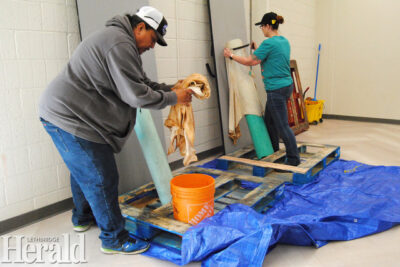Tanning workshop teaches old skills to new generation
By Ry Clarke - Lethbridge Herald Local Journalism Initiative Reporter on April 1, 2023.
 Herald photo by Ry Clarke
Blackfoot Resource Hub facilitator Winston Wadsworth Jr. wrings out a hide while participant Zoey Glass scrapes away at another this week at the Interfaith Food Bank.
Herald photo by Ry Clarke
Blackfoot Resource Hub facilitator Winston Wadsworth Jr. wrings out a hide while participant Zoey Glass scrapes away at another this week at the Interfaith Food Bank.The Blackfoot Resource Hub hosted a four-day leather tanning workshop at the Interfaith Food Bank this week.
The Hub invited people to learn the art of Indigenous leather tanning and customs and culture. The workshop was aimed at teaching skills of the trade that are being lost to time – passing along the teachings and techniques from one generation to the next.
“It’s a lost skill amongst people. It’s a skill, not art. Art is made from it. But the skill of hide tanning has been lost amongst people to the way of commercial tanning, which is all done with chemicals,” said Iitstsaansski (Sings in the Trees) Winston Wadsworth Jr, facilitator for the event. “Our tanning, you can eat this hide if you are starving, because all I use is brains and eggs.”
The process was taught to Wadsworth from his grandmother and now he is teaching his skills to others to pass the tradition along. “There was no IGA or Walmart like there is today, so we had to have these skills. I joined her and she blessed me over the hide and she said ‘Now you can start doing it,’ and I started helping her. Now I’m 52, been doing it for 42 years. When I did my first hide, I was 10 and I gave it back to her. She always said, your first hide you always give away. So I gave it to her and she made several moccasins out of it,” said Wadsworth.
Teaching respect and care for the animal, Wadsworth notes the process of taking the skin and tanning it.
“We’re going to skin it, flesh it and then de-hair it. Then we scrape it dry, flip to the hair side and dry scrape it. You’ll put it on a frame and scrape some more. You need to get all the hair and epidermis off. Once you get that done then you cook the brains with eggs and make a mixture rubbing it on. You sit there and wring it with your hands,” said Wadsworth. “You’ll start to see it soften and start turning white. If it’s not soft enough you go back a few steps and do it again. Once you got it to your liking, you sew it up into a tube and make a fire and smoke it with cottonwood.. . then it’s done, and that’s four or six days later.”
Wadsworth notes the process can take longer depending on the size of the hide and the quality.
The process takes strong arms and patience, but with the time and care a quality piece of leather can have many uses.
“It’s a long process, and I think that’s why a lot of people have backed away from it. People would rather go buy a hide,” said Wadsworth. “But in the end, as a craftsperson, you capitalize 100 per cent – those are my grandmother’s words.”
Wadsworth notes the cultural and spiritual side of tanning.
“We do a lot of drum-making, regalias as well, and moccasins. My grandmother used to say when you do a hide and make it into something. It may be physically gone, but when you make a hand drum, it comes back alive through the song. When you make a pair of moccasins, you bring it back to life through walking,” said Wadsworth.
Sharing culture and traditions with those in the community, the Blackfoot Resource Hub brought new insights through heritage.
“I want them to learn. I need them to learn. Because then it lives on through me to them, to their children, into the future. It will never die,” said Wadsworth.
14-13


